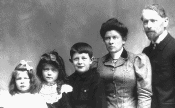Personal life
Piaget was born in
1896 in Neuchatel, in the Francophone region of Switzerland. He was the eldest
son of Arthur Piaget (Swiss), a professor of medieval literature at the
University of Neuchatel, and Rebecca Jackoson (French). Piaget was a precocious
child who developed an interest in biology and the natural world. His early
interest in zoology earned him a reputation among those in the field after he
had published several articles on mollusks by the age of 15. He was educated at
the University of Neuchatel, and studied briefly at the University of Zurich.
During this time, he published two philosophical papers that showed the
direction of his thinking at the time, but which he later dismissed as
adolescent thought. His interest in psychoanalysis, at the time a burgeoning
strain of psychology, can also be dated to this period.
His interest for mollusks was developed during his late adolescence to
the point that he became a well-known malacologist by finishing school. He
published many papers in the field that remained of interest for him all along
his life.
After high school
graduation, he studied natural sciences at the University of Neuchâtel where he
obtained a Ph.D. During this period, he published two philosophical essays
which he considered as "adolescence work" but were important for the
general orientation of his thinking. (Ame)
After a semester spent at the University of Zürich where he
developed an interest for psychoanalysis, he left Switzerland for France. He
spent one year working at the Ecole de la rue de la Grange-aux-Belles a boys'
institution created by Alfred Binet and then directed by De Simon who had
developed with Binet a test for the measurement of intelligence. There, he
standardized Burt's test of intelligence and did his first experimental studies
of the growing mind.
In 1921, he became director of studies at the J.-J. Rousseau
Institute in Geneva at the request of Sir Ed. Claparède and P. Bovet. In
1923, he and Valentine Châtenay were married. The couple had three children,
Jacqueline, Lucienne and Laurent whose intellectual development from infancy to
language was studied by Piaget. He died 16 September 1980 at aged of 84.
Career History
"The
principle goal of education in the schools should be creating men and women who
are capable of doing new things, not simply repeating what other generations
have done.
-Jean Piaget-
-Jean Piaget-
He began showing an interest in the natural sciences at a
very early age. By age 11, he had already started his career as a researcher by
writing a short paper on an albino sparrow. He continued to study the natural
sciences and received his Ph.D. in Zoology from University of Neuchâtel in
1918.
Successively
or simultaneously, Piaget occupied several chairs: psychology, sociology and
history of science at Neuchâtel from 1925 to 1929; history of scientific
thinking at Geneva from 1929 to 1939; the International Bureau of Education
from 1929 to 1967; psychology and sociology at Lausanne from 1938 to 1951;
sociology at Geneva from 1939 to 1952, then genetic and experimental psychology
from 1940 to 1971. He was, reportedly, the only Swiss to be invited at the Sorbonne
from 1952 to 1963. In 1955, he created and directed until his death the
International Center for Genetic Epistemology. (Arc)
Theory and application of theory
Cognitive Development
According to psychologist Jean
Piaget, children progress through a series of four key stages of cognitive
development marked by shifts in how they understand the world. Piaget believed
that children are like "little scientists" and that they actively try
to explore and make sense of the world around them. Through his observations of
his own children, Piaget developed a stage theory of intellectual development
that included four distinct stages: the sensorimotor stage, from birth to age
2; the pre-operational stage, from age 2 to about age 7; the concrete
operational stage, from age 7 to 11; and the formal operational stage, which
begins in adolescence and spans into adulthood.
Schemas
A schema describes both the
mental and physical actions involved in understanding and knowing. Schemas are
categories of knowledge that help us to interpret and understand the world. In Piaget's view, a schema includes both a category of knowledge and the
process of obtaining that knowledge. As experiences happen, this new
information is used to modify, add to, or change previously existing schemas. For example, a child may have a schema about a type of animal, such as a
dog. If the child's sole experience has been with small dogs, a child might
believe that all dogs are small, furry, and have four legs. Suppose then that
the child encounters a very large dog. The child will take in this new
information, modifying the previously existing schema to include this new
information.

According to Piaget, children use the process
of assimilation and accommodation to create a schema or mental
framework for how they perceive and/or interpret what they are experiencing. As
a result, the early concepts of young children tend to be more global or general
in nature.
Assimilation is knowing new information and relating into
prior knowledge. For a example a child saw a butterfly in her coloring book and
she says it as a butterfly. Again when she saw a dragonfly while she was
playing in the park, so she related it to her prior knowledge and say it
is a butterfly. So assimilation forms. Than her parent correct her by
saying dragonfly accommodation takes place and new schema forms.



.jpg)


.jpg)



No comments:
Post a Comment